Monarch LB Yeti White – Low Cure Plastisol Ink
Introducing Monarch MP8-0104 Yeti LB White, a premium plastisol ink specially formulated for printing on challenging polyester fabrics. This low-cure ink delivers exceptional results, providing excellent coverage on dark garments while maintaining a bright, high-opacity white. With its non-phthalate, lead-free composition, Yeti LB White ensures both quality and safety in your printing projects.
$64.74 – $4,015.82
Description
Monarch LB Yeti White Low Cure Plastisol Ink Key Features:
- Substrate: Monarch Yeti LB White is designed to work seamlessly on various substrates, including Polyester Blends, Tri-Blends, Poly/Cotton, Cotton, and stretch fabrics.
- Creamy and Short Body: The creamy texture and short body of this ink make it easy to work with, allowing for smooth application and precise printing.
- Fast Flash and High Opacity: Yeti LB White offers a fast flash time, enabling efficient printing on high-speed presses. Its high-opacity formula ensures vibrant and consistent results, even on dark-colored garments.
- Bleed Resistance: This ink exhibits good bleed resistance across a wide temperature range, making it a reliable choice for printing on Polyester Blends.
- Bright White: Monarch Yeti LB White leaves a pristine, bright white finish on garments, elevating the quality and appeal of your prints.
- Properties:
- Wet Ink Tack: The low wet ink tack minimizes ink build-up on the screen, enabling smooth printing through finer mesh counts without the need for a viscosity modifier.
- Surface Appearance: Yeti LB White creates a satin finish on printed garments, enhancing their overall aesthetic appeal.
- Opacity: The ink’s high opacity ensures vibrant and solid coverage, ideal for achieving striking prints on dark fabrics.
- Gel Point: The gel point of 160 °F ensures efficient flash curing, enabling faster production speeds.
- Flash Temperature & Time: Yeti LB White requires a flash temperature between 230°F to 250°F and a brief flash time to set the ink for subsequent layers.
- Fusion Temperature: The ink cures at a low temperature range of 290°F to 320°F, making it suitable for use on heat-sensitive polyester fabrics.
- Squeegee Blade: Utilize a 70° to 80° durometer squeegee blade for optimal ink transfer and sharp print definition.
- Mesh Count: Yeti LB White performs exceptionally well through mesh counts ranging from 86 to 156 mc in, offering versatility in your printing setups.
Storage Instructions:
To ensure the longevity and optimal performance of Yeti LB White Plastisol Ink, it is essential to follow proper storage guidelines:
- Room Temperature Storage: Store the ink containers in a cool and dry environment at room temperature. Avoid exposing the ink to extreme temperatures, such as freezing or high heat, as this can negatively impact the ink’s consistency and printing properties.
- Avoid Direct Sunlight: Keep the ink away from direct sunlight or strong UV light sources. Prolonged exposure to sunlight can cause the ink to gel in the container and lead to undesirable changes in consistency.
- Avoid Warm Temperatures: Monarch Yeti LB White Plastisol Ink is a low-cure ink, and exposure to warmer temperatures can cause gelling, making it challenging to print or even ruin the product. Prevent storing the ink in areas prone to excessive heat.
- Proper Sealing: Always ensure that the ink containers are tightly sealed after each use. This prevents air and contaminants from entering the containers, maintaining the ink’s quality and preventing premature drying or thickening.
- Regular Inspection: Periodically check the ink containers for any signs of spoilage, contamination, or change in consistency. If any abnormalities are detected, refrain from using the ink and contact the manufacturer or supplier for assistance.
By following these storage instructions, you can prolong the shelf life of Monarch Yeti LB White Plastisol Ink and maintain its smooth texture and printing properties, ensuring exceptional results for your screen printing projects. Remember, proper ink storage is essential for achieving consistent and high-quality prints.
Note: Always follow safety guidelines and wear appropriate protective gear when working with plastisol ink and using conveyor dryers. Proper ventilation in the printing area is essential to minimize exposure to fumes.
By following these directions, using the right emulsion and mesh count, utilizing the Monarch Color Mixing System for custom Pantone colors, and implementing careful cooling and stacking practices, you can achieve exceptional results when printing with Monarch Yeti LB White Plastisol Ink on polyester. Happy printing!
Technical Specifications
Printing Directions for Monarch Yeti White Ink on Polyester:
Preparation: Ensure that the polyester fabric is clean and free from any contaminants. Pre-treat the fabric if required, following the manufacturer’s recommendations.
Screen Preparation: Use an emulsion specifically made for use with plastisol inks when coating your screens. To combat dye migration and achieve better ink coverage, opt for a lower mesh count such as 110 or 125. The lower mesh count will deposit a thicker layer of ink, enhancing color vibrancy and preventing dye migration.
Ink Mixing: Mix the Monarch Yeti White Ink thoroughly before use to achieve consistent color and texture. If you plan to create a custom Pantone color using this system, you can utilize the Monarch Color Mixing System available at the following link: Monarch Color Mixing System. This tool will aid you in achieving accurate Pantone matches for your printing projects.
Underbase/Gray Blocker: For challenging materials like polyester camo, consider using a white underbase or a gray blocker. The underbase will help enhance the vibrancy of the colors and prevent the fabric color from affecting the final print’s brightness.
Printing: Apply the ink to the screen and position it correctly over the garment. Flood the screen and ensure the ink fully covers the design area.
Print Stroke: Use a smooth and even print stroke to ensure even ink distribution on the fabric. For optimal results, use a single print stroke for one-stroke coverage whenever possible.
Curing Temperature: Polyester is sensitive to heat, and dyes in the fabric may migrate at high temperatures. To prevent dye migration and maintain the fabric’s color integrity, ensure your conveyor dryers are set between 290 to 320 degrees Fahrenheit (143 to 160 degrees Celsius). The Monarch Yeti White Ink cures at this temperature range, providing excellent adhesion and durability.
Curing Time: Maintain the garment inside the conveyor dryer for a full minute and a half. This duration allows the ink to fully cure and adhere to the fabric. Always perform a stretch test after curing to ensure the ink does not crack and is fully cured onto the garment.
Cooling and Stacking: Be cautious when stacking freshly cured shirts, as certain dyes can gas and transfer onto the back of the next shirt if they are stacked while too hot. To prevent this, we recommend making three stacks so each shirt has longer to cool and reduce the risk of dye transfer. Alternatively, consider adding a fan cooling bar at the end of your conveyor belt exit feed to enhance cooling and prevent unwanted dye migration.
Testing and Quality Control: Perform a wash test on a sample garment to ensure the ink adheres properly and retains its color after washing. Check for any issues related to dye migration or color changes.
Clean Up: Clean screens and equipment thoroughly after printing to maintain their longevity and ensure consistent print quality in future runs.
Storage Instructions:
To ensure the longevity and optimal performance of Monarch Yeti White Ink, it is essential to follow proper storage guidelines:
- Room Temperature Storage: Store the ink containers in a cool and dry environment at room temperature. Avoid exposing the ink to extreme temperatures, such as freezing or high heat, as this can negatively impact the ink’s consistency and printing properties.
- Avoid Direct Sunlight: Keep the ink away from direct sunlight or strong UV light sources. Prolonged exposure to sunlight can cause the ink to gel in the container and lead to undesirable changes in consistency.
- Avoid Warm Temperatures: Monarch Yeti White Ink is a low-cure ink, and exposure to warmer temperatures can cause gelling, making it challenging to print or even ruin the product. Prevent storing the ink in areas prone to excessive heat.
- Proper Sealing: Always ensure that the ink containers are tightly sealed after each use. This prevents air and contaminants from entering the containers, maintaining the ink’s quality and preventing premature drying or thickening.
- Regular Inspection: Periodically check the ink containers for any signs of spoilage, contamination, or change in consistency. If any abnormalities are detected, refrain from using the ink and contact the manufacturer or supplier for assistance.
By following these storage instructions, you can prolong the shelf life of Monarch Yeti White Ink and maintain its smooth texture and printing properties, ensuring exceptional results for your screen printing projects. Remember, proper ink storage is essential for achieving consistent and high-quality prints.
Note: Always follow safety guidelines and wear appropriate protective gear when working with plastisol ink and using conveyor dryers. Proper ventilation in the printing area is essential to minimize exposure to fumes.
By following these directions, using the right emulsion and mesh count, utilizing the Monarch Color Mixing System for custom Pantone colors, and implementing careful cooling and stacking practices, you can achieve exceptional results when printing with Monarch Yeti White Ink on polyester. Happy printing!
Before proceeding with the printing process, it is crucial to perform a test on a sample garment using Monarch Yeti White Ink. Testing the ink on a sample garment ensures that the color remains consistent during the curing process and in the days following printing.
Please note that River City or any affiliated entities are not responsible for any issues related to dye migration or incorrect use of this product. It is the user’s responsibility to conduct proper testing and adhere to recommended guidelines for the best printing results.
Technical Sheets / Safety Data Sheets / Documents
Video
Reviews
Only logged in customers who have purchased this product may leave a review.

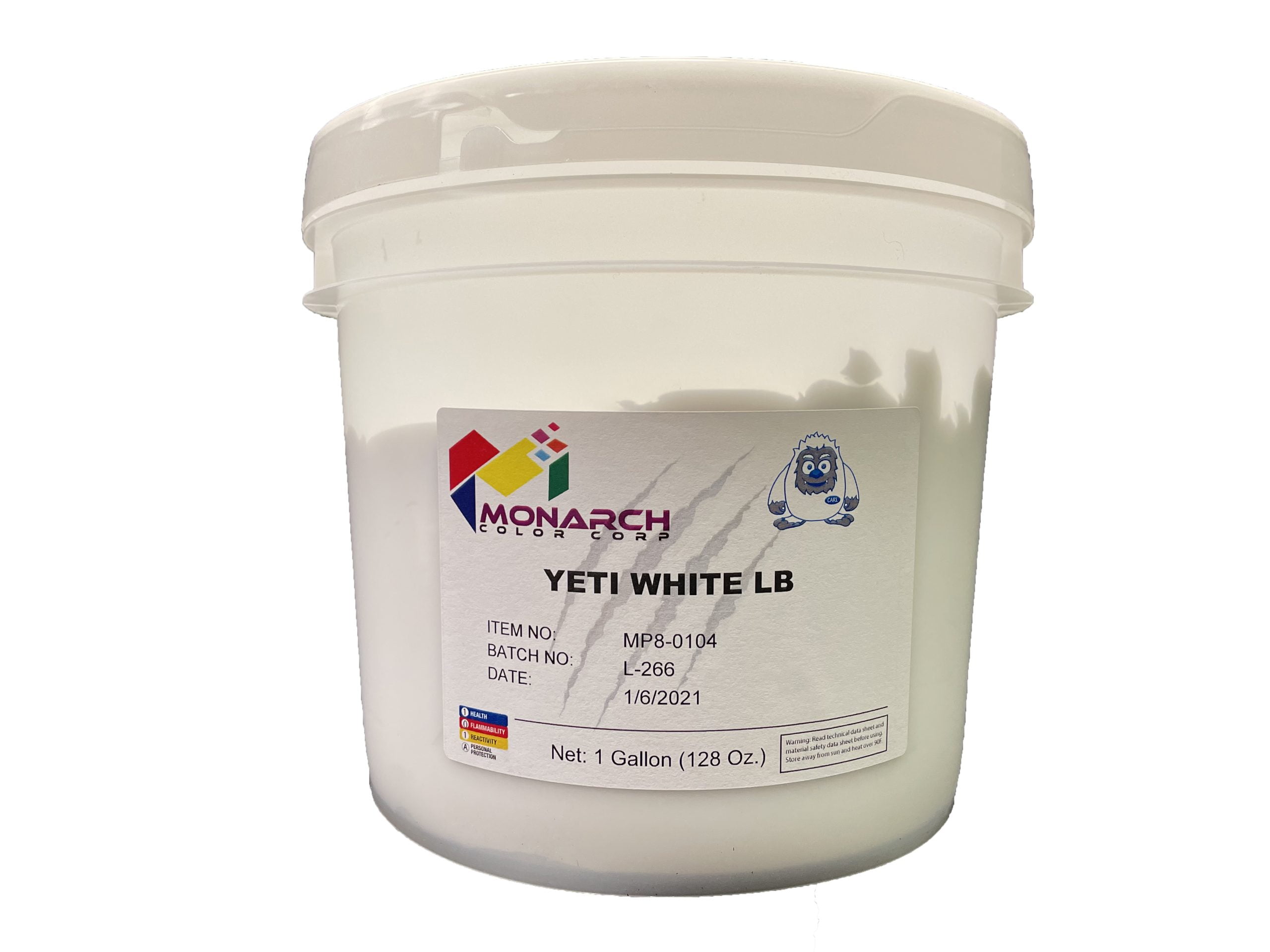
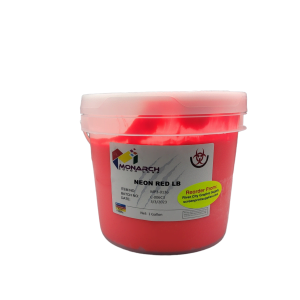
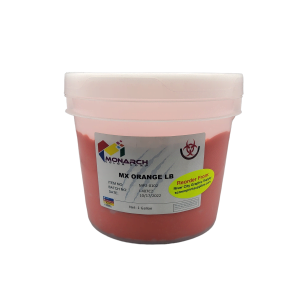
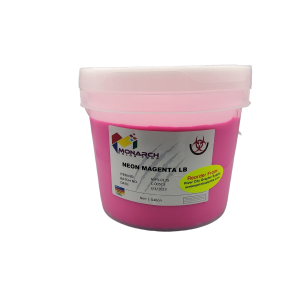
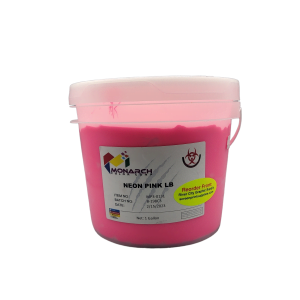
Reviews